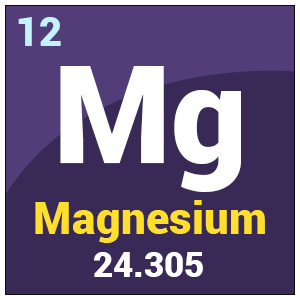The atomic number of magnesium (Mg) is 12. The atomic weight of Mg is 24.3050 grams per mole.See the Web Links to the left of this answer for a periodic table with more information about this element! There are mainly three Magnesium isotopes that are stable: Mg 24, 25 and 26. The abundance on earth of the first is 79% the second 10% and the third 11%. The relative atomic mass of Magnesium (the average of all the masses of the stable isotopes) is stated as 24.31 in most of the periodic tables and 24.305 in more specific references. The atomic number of magnesium 6 letters. So you cannot find the answer to The atomic number of magnesium clue on Mystic Words game. Well, we can help you with that. Mystic Words is a recent word game released for iOS and Android devices, with a style similar to 7 Little Words. Atomic Number of Magnesium Magnesium is a chemical element with atomic number 12 which means there are 12 protons and 12 electrons in the atomic structure. The chemical symbol for Magnesium is Mg. The atom consist of a small but massive nucleus surrounded by a cloud of rapidly moving electrons.
- Atomic Number Of Magnesium Oxide
- Atomic Number Of Magnesium Ion
- Magnesium Atomic Model
- Atomic Number Of Magnesium-24
We elaborate the uses of magnesium and atomic properties with characteristics. Magnesium is a silver-white chemical element with an atomic number of 12. Its symbol is Mg and belongs to the group of alkaline earth metals and its usual state in nature is solid. Magnesium is located at position 12 on the periodic table.
You Can Visit Our Managed: Periodic Table Main Page
On this page you can discover the chemical properties of magnesium and information about magnesium and other elements on the periodic table such as beryllium, calcium, sodium or aluminum. You will also learn what magnesium is for and you will know what its uses are through its properties associated with magnesium such as its atomic number or the usual state in which magnesium can be found.
You will be able to see magnesium qualities such as its melting and boiling point, its magnetic properties or what its chemical symbol is. In addition, here you will find information about its atomic properties such as the distribution of electrons in magnesium atoms and other properties.
For some elements, some of this information is unknown. In these cases we show the properties attributed to them.
Properties of magnesium
The alkaline earth metals, among which is magnesium, have properties such as being soft, colored and having a low density. Elements like magnesium have low ionization energy. All alkaline earth metals form ionic compounds except for beryllium.
The state of magnesium in its natural form is solid (paramagnetic). Magnesium is a silver-white chemical element and belongs to the group of alkaline earth metals. The atomic number of magnesium is 12. The chemical symbol for magnesium is Mg. The melting point of magnesium is 923 degrees Kelvin or 650.85 degrees Celsius or degrees Celsius. The boiling point of magnesium is 1363 degrees Kelvin or 1090.85 degrees Celsius or degrees Celsius.
Magnesium is a mineral that our body needs for its proper functioning and can be found in food. Through the following link, you can find a list of foods with magnesium .
Uses of magnesium
Magnesium is the ninth most abundant element in the universe and the most abundant in the Earth’s crust. If you’ve ever wondered what hydrogen is for , here is a list of its possible uses: Ies ve pro.
- In the Kroll process, magnesium is used to obtain titanium .
- Magnesium is both strong and light. This makes it ideal for use on auto and truck parts. It is often alloyed with other strong metals (eg, aluminum).
- Due to its low weight and good mechanical and electrical properties, magnesium is used in the manufacture of mobile phones (also called mobile phones), laptops, and cameras. It can also be used to make other electrical components.
- Three different magnesium compounds are used as antiseptics.
- Fabrics treated with magnesium compounds are resistant to moths.
- Magnesium sulfite is used in papermaking.
- Magnesium bromide can be used as a mild sedative. However, it is the action of bromine that causes the sedative effect.
- The powder that gymnasts and weightlifters use to improve grip is magnesium carbonate.
- Magnesium ions are essential for all living things. Therefore, magnesium salts are added to food and fertilizers.
- Magnesium can be used as a uranium- producing reducing agent from its salt.
- Since magnesium produces bright white light when burned, it is ideal for use in flash photography, flares, and fireworks.
Atomic properties of magnesium
The atomic mass of an element is determined by the total mass of neutrons and protons that can be found in a single atom belonging to this element. As for the position where to find magnesium within the periodic table of the elements, magnesium is in group 2 and period 3. Magnesium has an atomic mass of 24,305 u.

The electronic configuration for magnesium is [Ne] 3s2. The electronic configuration of the elements, determines the form in which the electrons are structured in the atoms of an element. The average radius for magnesium is 150 pm, its atomic radius or Bohr radius is 145 pm, its covalent radius is 130 pm, and its Van der Waals radius is 173 pm.
You Can Visit Our Managed: Periodic Table Main Page
Magnesium characteristics
Below you can see a table showing the main characteristics that magnesium has.
| Magnesium | ||
|---|---|---|
| Chemical symbol | Mg | |
| Atomic number | 12 | |
| Group | 2 | |
| Period | 3 | |
| Appearance | silver white | |
| Block | s | |
| Density | 1738 kg / m3 | |
| Atomic mass | 24,305 u | |
| Average radius | 150 pm | |
| Atomic radio | 145 | |
| Covalent radius | 130 pm | |
| Van der Waals radio | 173 pm | |
| Electronic configuration | [Ne] 3s2 | |
| Oxidation states | 2 (middle base) | |
| Crystal structure | hexagonal | |
| State | solid | |
| Melting point | 923 K | |
| Boiling point | 1363 K | |
| Heat of fusion | 8,954 kJ / mol | |
| Vapor pressure | 361 Pa to 923 K | |
| Electronegativity | 1.31 | |
| Specific heat | 1020 J / (K · kg) | |
| Electric conductivity | 22.6 × 106S / m | |
| Thermal conductivity | 156 W / (Km) | |
You Can Visit Our Managed: Periodic Table Main Page
Atomic Number Of Magnesium Oxide
MAGNESIUM
Magnesium is a macro element with the atomic number of 12 and also known as the anti-stress mineral. It is an important nutrient for the brain as it raises the resistance against stress, depression, tensions and helps against mental tiredness. It also strengthens the memory and concentration. Magnesium is involved in releasing energy from the diet and is involved in a good functioning nervous system and muscles. It is also involved in the formation of strong bones and teeth and is active as an assistant cofactor of the B and C vitamins.
Magnesium is necessary for many body functions, such as energy production and cell division and is essential for the transfer of nerve impulses. It protects against heart and vascular diseases, repairs and maintains the cells and is necessary for hormone production and can lower blood pressure. Magnesium is useful in the treatment of fibromyalgia, prostate problems, 'restless legs' and premenstrual tension.
This mineral acts as a co-factor for more than 300 enzymes, including enzymes involved in the body's use of glucose and insulin secretion. Libxenoverse download. All human tissues contain small amounts of magnesium. The adult human body contains about 25 g of this mineral. The greater part of this amount is present in bones in combination with phosphate and carbonate. Bone ashes contain less than one per cent magnesium. About one-fifty of the total magnesium in the body is present in the soft tissues, where it is mainly bound to protein. Next to potassium, magnesium is the predominant metallic action in living cells. The bones seem to provide a reserve supply of this mineral in case of shortage elsewhere in the body.

Magnesium is the mineral that stabilises the heart, calms the nerves and regulates the heart beat. Biochemists call magnesium the ' cool, alkaline, refreshing, sleep-promoting mineral'. Magnesium helps one keep calm and cool during the sweltering summer months. It aids in keeping nerves relaxed and normally balanced and is necessary for all muscular activity.
This mineral is an activator for most of the enzyme system involving carbohydrate, fat and protein in energy-producing reactions. It is also involved in the production of lecithin which prevents the building up of cholesterol and consequent atherosclerosis. Magnesium promotes a healthier cardiovascular system and aids in fighting depression. It helps prevent calcium deposits in the kidneys and gallbladder and also brings relief from indigestion. This mineral together with vitamin B6 (pyridoxine) has also been found effective in the prevention and treatment of bladder, kidney stones and bile and gall stones. Magnesium has also proved useful in other bladder and urinary problems and in epileptic seizure.
Magnesium is nature's own calcium channel blocker. When there is enough magnesium around, veins and arteries breathe a sigh of relief and relax, which lessens resistance and improves the flow of blood, oxygen and nutrients throughout the body. Studies show that a deficiency of magnesium is not only associated with heart attack but that immediately following a heart attack, lack of sufficient magnesium promotes free radical injury to the heart.
Magnesium rich foods are commonly recommended to people who suffer from asthma issues. It can increase lung capacity and build on the efficiency of the respiratory process.
Atomic Number Of Magnesium Ion

Canopus xplode pro 4.60 for adobe premiere. Magnesium deficiency
It is estimated that 80% of the population of western countries are magnesium deficient. Magnesium deficiency was the cause of death from sudden heart attacks in 8 million people in the USA from 1940-1994. Diabetes can cause magnesium expulsion and lead to heart attacks.

Heavy drinkers and alcoholics often show a low plasma magnesium concentration and a high urinary output. They may, therefore, require magnesium therapy especially in an acute attack of delirium tremens.
Too much phosphorous can cause diarrhoea and calcification (hardening) of organs and soft tissue and can interfere with the body's ability to useiron,calcium,magnesium and zinc. It is a matter of getting the balance right which is why supplementation is not advised. Foods that contain these minerals will never overdose the consumer with phosphorous.
Magnesium Atomic Model
Some bottled mineral waters contain good amounts of magnesium but some do not so it is best to always check labels. The treatments done to some bottled waters and tap water can remove the magnesium content altogether.
Atomic Number Of Magnesium-24
The body does not store magnesium like it does calcium. Magnesium is excreted as a result of drinking alcohol or high caffeine drinks such as coffee and fizzy drinks, high stress, diarrhoea, sugar intake or high levels of protein and fruit in the diet.
